Physics Simulation
Below is the result of Chimera's Breath by nimitz running in PixelsWorld. View the full video.
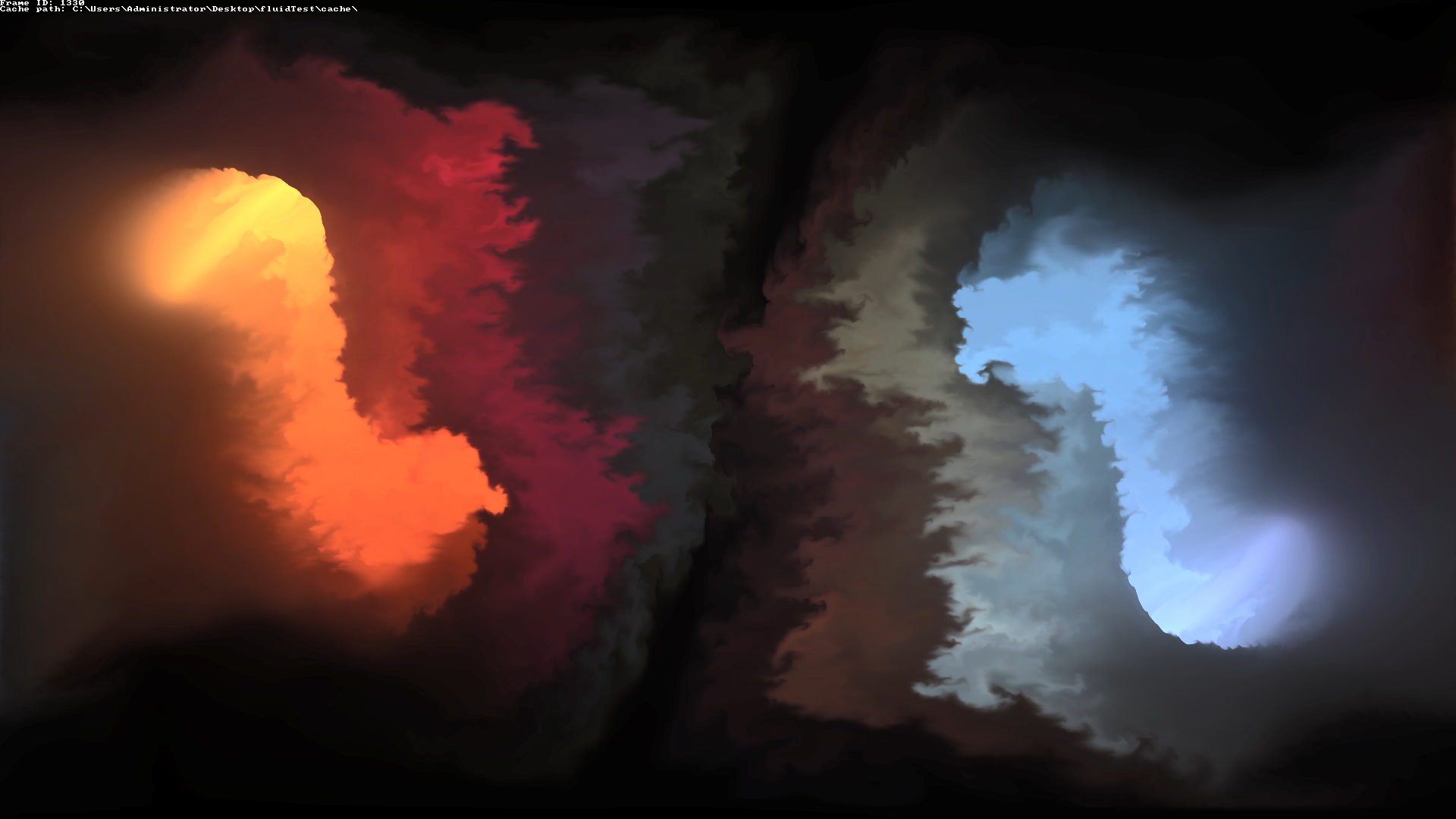
This chapter will introduce how to cache data in PixelsWorld.
Note: Due to limited Ae functionality, please strictly follow the cache specifications outlined in this manual.
- Please ensure you have
v3.3.3+version of PixelsWorld.- This article assumes the reader has a certain proficiency in Ae operations and PixelsWorld coding. If you are not yet familiar with using PixelsWorld, please refer to previous chapters.
- We recommend turning off Ae's multi-core rendering functionality.
Caching Data
To cache data in PixelsWorld, follow these steps:
Code logic:
- Set the cache location and cache file name.
- Calculate
frameId=time*fps. - Calculate
lastFrameId=frameId-1. - If
lastFrameIdis less than 0, go to step 5; otherwise, go to step 6. - Initialize data, then go to step 7.
- Read the previously stored simulation data file for the previous frame, throw an error if the file does not exist, then go to step 7.
- Compute the simulation data for the current frame.
- Store the current frame's simulation data locally.
Operational logic:
- Insert code satisfying the above logic into PixelsWorld.
- Move the time indicator to the beginning of the current layer.
- Clear all Ae caches (
Edit->Purge->All Memory & Disk Cache...as shown below). - Hold
Ctrl+Altand click the LOGO on the plugin panel (optional step). - Press the spacebar to start rendering (do not render sporadically).
Note: If you encounter any undesired situations (errors, flickering images, etc.), repeat steps 2-5.
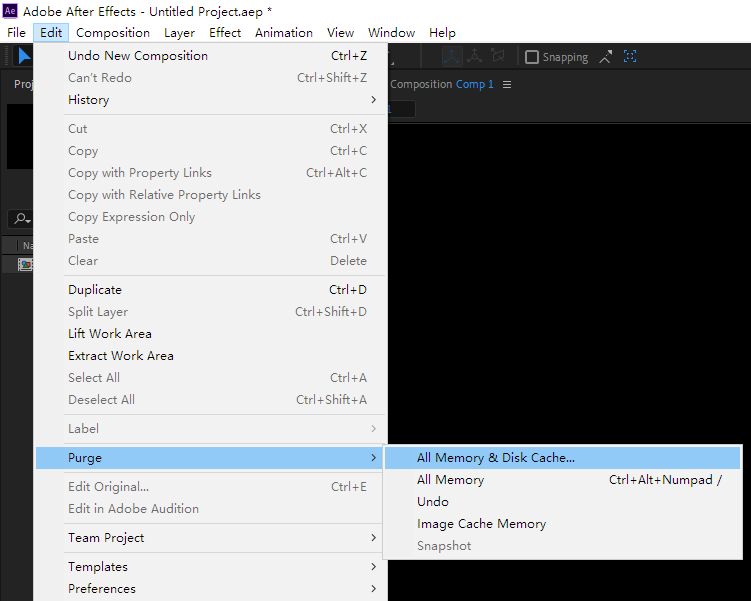
Caching Textures
Code logic:
- An error occurs if downsampling (half, quarter mode) is active.
- Set the cache location and cache file name.
- Calculate
frameId=time*fps. - Calculate
lastFrameId=frameId-1. - If
lastFrameIdis less than 0, go to step 5; otherwise, go to step 6. - Initialize data, then go to step 7.
- Read the previously stored texture file for the previous frame, throw an error if the file does not exist, then go to step 7.
- Compute the texture file for the current frame.
- Store the current frame's texture file locally.
For texture operations, refer to the Textures chapter.
Operational logic:
- Insert code satisfying the above logic into PixelsWorld.
- Set
Advanced->Internal texture formatin the plugin panel toFloating point 32bit x RGBA (HDR). - Move the time indicator to the beginning of the current layer.
- Clear all Ae caches (
Edit->Purge->All Memory & Disk Cache...). - Hold
Ctrl+Altand click the LOGO on the plugin panel (optional step). - Press the spacebar to start rendering (do not render sporadically).
Practicing Data Caching - The Three-Body Problem Simulation
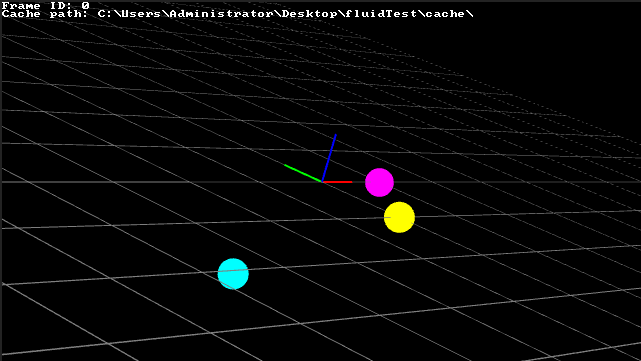
the_three_body_problem.lua
version3()
-- Import vector library
require("veclib")
-- Set cache file name
local cacheFileName = "A"
-- Declare function to check if a file exists (function source: https://stackoverflow.com/questions/4990990/check-if-a-file-exists-with-lua)
function file_exists(name)
local f=io.open(name,"r")
if f~=nil then io.close(f) return true else return false end
end
-- Calculate the current frame number and round to the nearest integer
local frameId = math.floor(time * fps + .5)
-- Calculate the previous frame number
local lastFrameId = frameId -1
-- Check if the current frame number is non-negative, throw an error if it's negative.
assert(frameId >= 0, "FrameId not support")
-- Print the current frame number (this line can be deleted)
println("Frame ID: " .. frameId)
-- Set cache folder (here I'm using the cache folder next to the aep project folder as the directory, save the project before using projectFolder)
local cachePath = projectFolder .. "cache\\"
-- Print the current output folder (this line can be deleted)
println("Cache path: " .. cachePath)
-- If the current frame number is 0 (i.e., the previous frame is less than 0)
if(lastFrameId < 0) then
-- Initialize the positions and velocities of the three objects
p1 = vec3(100,0,0)
v1 = vec3(-0.1,-0.1,-0.5)
p2 = vec3(0,-100,0)
v2 = vec3(0,0.1,0)
p3 = vec3(-100,0,-95)
v3 = vec3(0.1,0,0.5)
else
-- Check if the previous frame's cache file exists
if(file_exists(cachePath .. cacheFileName .. "_" .. tostring(lastFrameId) .. ".txt")) then
-- Read the locally stored data from the previous frame
lua(loadString(cachePath .. cacheFileName .. "_" .. tostring(lastFrameId) .. ".txt"))
else
-- Throw an error if it doesn't exist
error("Please go back to frame 0 to re-cache your comp")
end
end
-- Start physical simulation
center = vec3(width/2,height/2,0)
f1,f2,f3 = vec3(0),vec3(0),vec3(0)
r = 15
m1=8
m2=10
m3=5
dp12,dp13,dp23 = p1-p2,p1-p3,p2-p3
f1 = f1 + m1*m2/math.max(dot(dp12,dp12),1e-1) * (-dp12)
f2 = f2 + m1*m2/math.max(dot(dp12,dp12),1e-1) * (dp12)
f1 = f1 + m1*m3/math.max(dot(dp13,dp13),1e-1) * (-dp13)
f3 = f3 + m1*m3/math.max(dot(dp13,dp13),1e-1) * (dp13)
f2 = f2 + m3*m2/math.max(dot(dp23,dp23),1e-1) * (-dp23)
f3 = f3 + m3*m2/math.max(dot(dp23,dp23),1e-1) * (dp23)
v1 = v1 + f1*(1/m1)
p1 = p1 + v1
v2 = v2 + f2*(1/m2)
p2 = p2 + v2
v3 = v3 + f3*(1/m3)
p3 = p3 + v3
-- Physical simulation ends
-- Store the positions and velocities of the three objects locally
saveString(
cachePath .. cacheFileName .. "_" .. tostring(frameId) .. ".txt",
string.format([==[
p1=vec3(%f,%f,%f);v1=vec3(%f,%f,%f);
p2=vec3(%f,%f,%f);v2=vec3(%f,%f,%f);
p3=vec3(%f,%f,%f);v3=vec3(%f,%f,%f);
]==],
p1.x,p1.y,p1.z,v1.x,v1.y,v1.z,
p2.x,p2.y,p2.z,v2.x,v2.y,v2.z,
p3.x,p3.y,p3.z,v3.x,v3.y,v3.z
)
)
-- Render the three spheres using the current frame's simulation data
dim3()
move(center.x,center.y,center.z)
-- Draw axes and grid
coord()
grid()
-- First sphere
beginGroup()
move(p1.x,p1.y,p1.z)
fill(1,0,1)
ball(r)
endGroup()
-- Second sphere
beginGroup()
fill(1,1,0)
move(p2.x,p2.y,p2.z)
ball(r)
endGroup()
-- Third sphere
beginGroup()
fill(0,1,1)
move(p3.x,p3.y,p3.z)
ball(r)
endGroup()
Practicing Texture Caching - Conway's Game of Life
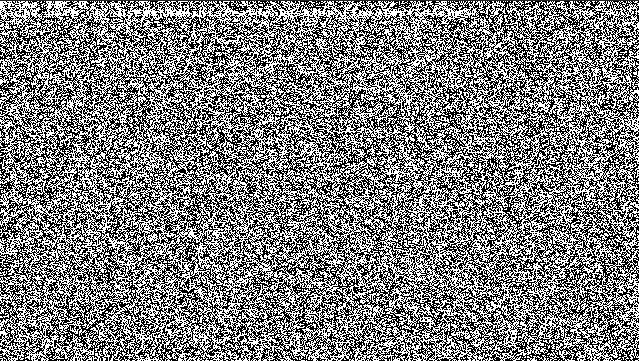
game_of_life.lua
version3()
-- Check for downsampling
assert(width == ds_width and height == ds_height , "Downsample not supported" )
-- Declare function to check if a file exists (function source: https://stackoverflow.com/questions/4990990/check-if-a-file-exists-with-lua)
function file_exists(name)
local f=io.open(name,"r")
if f~=nil then io.close(f) return true else return false end
end
-- Calculate the current frame number and round to the nearest integer
local frameId = math.floor(time * fps + .5)
-- Calculate the previous frame number
local lastFrameId = frameId -1
-- Check if the current frame number is non-negative, throw an error if it's negative.
assert(frameId >= 0, "FrameId not supported")
-- Print the current frame number (this line can be deleted)
println("Frame ID: " .. frameId)
-- Set cache path
local cachePath = projectFolder .. "cache\\"
println("Cache path: " .. cachePath)
-- Check if it is the first frame
if(lastFrameId < 0) then
-- Initialize texture
lastTexA = newTex(width,height)
else
-- Check if the previous frame exists
if(file_exists(cachePath .. "A_" .. tostring(lastFrameId) .. ".raw")) then
-- Import the previous frame's texture
lastTexA = loadRAW(cachePath .. "A_" .. tostring(lastFrameId) .. ".raw")
else
error("Please go back to frame 0 to cache your comp")
end
end
-- Set rendering code
local fragCode = [==[
// Definition from: https://en.wikipedia.org/wiki/Conway%27s_Game_of_Life
// MIT license (Free for study and business purpose)
// Code by ZzStarSound
const int dx[8] = int[](-1,0,1,1,1,0,-1,-1);
const int dy[8] = int[](1,1,1,0,-1,-1,-1,0);
bool fetchStatus(int ox, int oy)
{
ivec2 iuv = ivec2(floor(uv*resolution.xy)) + ivec2(ox,oy);
ivec2 res = ivec2(floor(resolution.xy));
if(iuv.x >= res.x || iuv.x < 0 || iuv.y >=res.y || iuv.y<0) return false;
return texelFetch(layer[0],iuv,0).x>.5;
}
// From https://thebookofshaders.com/10/
float random (vec2 st) {
return fract(sin(dot(st.xy, vec2(12.9898,78.233)))* 43758.5453123);
}
void main(){
if(time == 0.)
{
outColor = vec4(random(uv)>.5);
}else{
bool curstatus = fetchStatus(0,0);
int roundCount = 0;
for(int i = 0;i<8;i++){
if(fetchStatus(dx[i],dy[i])) roundCount ++ ;
}
if(curstatus)
{
if(roundCount < 2 || roundCount > 3) outColor = vec4(0);
else outColor = vec4(curstatus);
}
else
{
if(roundCount == 3) outColor = vec4(1);
else outColor = vec4(0);
}
}
}
]==]
-- Place the previous frame image at PARAM0 so that glsl can read the previous frame's texture from layer[0]
swapTex(PARAM0,lastTexA)
-- Render code
glsl(fragCode)
-- Place the previous frame image back to its original position
swapTex(PARAM0,lastTexA)
-- Save the current frame's texture locally
saveRAW(cachePath .. "A_" .. tostring(frameId) .. ".raw",OUTPUT)
Practicing Texture Caching - Fluid Simulation
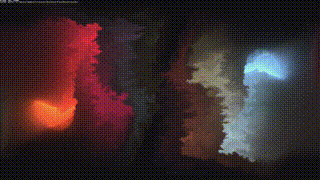
- Note: According to the code license requirements of the original author, the following code is for educational and non-commercial use only.
- Don't forget to change the
Internal texture formatsetting on the plugin panel toFloating point 32 bit x RGBA (HDR).- Please ensure you have read the previous operational instructions before starting the simulation! Read More>>>
- Setting
Mipmap filtertoNONEcan speed up the process.
fluid_simulation.lua
version3()
assert(width == ds_width and height == ds_height , "Downsample not supported" )
function file_exists(name)
local f=io.open(name,"r")
if f~=nil then io.close(f) return true else return false end
end
local frameId = math.floor(time * fps + .5)
local lastFrameId = frameId -1
assert(frameId >= 0, "FrameId not supported")
println("Frame ID: " .. frameId)
local cachepath = projectFolder .. "cache\\"
println("Cache path: " .. cachepath)
if(lastFrameId < 0) then
lastTexC = newTex(width,height)
lastTexD = newTex(width,height)
drawTo(lastTexC)
background(0,0,0,1)
drawTo(lastTexD)
background(0,0,0,1)
drawTo(OUTPUT)
else
path_c = cachepath .. "C_" .. tostring(lastFrameId) ..".raw"
path_d = cachepath .. "D_" .. tostring(lastFrameId) ..".raw"
if(file_exists(path_c) and file_exists(path_d) ) then
lastTexC = loadRAW(path_c)
lastTexD = loadRAW(path_d)
else
error("Please go back to frame 0 to cache your comp")
end
end
local commonCode = [==[
//Chimera's Breath
//by nimitz 2018 (twitter: @stormoid)
/*
The main interest here is the addition of vorticity confinement with the curl stored in
the alpha channel of the simulation texture (which was not used in the paper).
This in turn allows for believable simulation of much lower viscosity fluids.
Without vorticity confinement, the fluids that can be simulated are more akin to
thick oil.
Base Simulation based on the 2011 paper: "Simple and fast fluids"
(Martin Guay, Fabrice Colin, Richard Egli)
(https://hal.inria.fr/inria-00596050/document)
The actual simulation only requires one pass, Buffer A, B, and C are just copies
of each other to increase the simulation speed (3 simulation passes per frame),
and Buffer D is drawing colors on the simulated fluid
(could be using particles instead in a real scenario).
*/
#define dt 0.15
#define USE_VORTICITY_CONFINEMENT
//#define MOUSE_ONLY
//Recommended values between 0.03 and 0.2
//Higher values simulate lower viscosity fluids (think billowing smoke)
#define VORTICITY_AMOUNT 0.11
float mag2(vec2 p){return dot(p,p);}
vec2 point1(float t) {
t *= 0.62;
return vec2(0.12,0.5 + sin(t)*0.2);
}
vec2 point2(float t) {
t *= 0.62;
return vec2(0.88,0.5 + cos(t + 1.5708)*0.2);
}
vec4 solveFluid(sampler2D smp, vec2 uv, vec2 w, float time)
{
const float K = 0.2;
const float v = 0.55;
vec4 data = textureLod(smp, uv, 0.0);
vec4 tr = textureLod(smp, uv + vec2(w.x , 0), 0.0);
vec4 tl = textureLod(smp, uv - vec2(w.x , 0), 0.0);
vec4 tu = textureLod(smp, uv + vec2(0 , w.y), 0.0);
vec4 td = textureLod(smp, uv - vec2(0 , w.y), 0.0);
vec3 dx = (tr.xyz - tl.xyz)*0.5;
vec3 dy = (tu.xyz - td.xyz)*0.5;
vec2 densDif = vec2(dx.z ,dy.z);
data.z -= dt*dot(vec3(densDif, dx.x + dy.y) ,data.xyz); //density
vec2 laplacian = tu.xy + td.xy + tr.xy + tl.xy - 4.0*data.xy;
vec2 viscForce = vec2(v)*laplacian;
data.xyw = textureLod(smp, uv - dt*data.xy*w, 0.).xyw; //advection
vec2 newForce = vec2(0);
newForce.xy += 0.75*vec2(.0003, 0.00015)/(mag2(uv-point1(time))+0.0001);
newForce.xy -= 0.75*vec2(.0003, 0.00015)/(mag2(uv-point2(time))+0.0001);
data.xy += dt*(viscForce.xy - K/dt*densDif + newForce); //update velocity
data.xy = max(vec2(0), abs(data.xy)-1e-4)*sign(data.xy); //linear velocity decay
#ifdef USE_VORTICITY_CONFINEMENT
data.w = (tr.y - tl.y - tu.x + td.x);
vec2 vort = vec2(abs(tu.w) - abs(td.w), abs(tl.w) - abs(tr.w));
vort *= VORTICITY_AMOUNT/length(vort + 1e-9)*data.w;
data.xy += vort;
#endif
data.y *= smoothstep(.5,.48,abs(uv.y-0.5)); //Boundaries
data = clamp(data, vec4(vec2(-10), 0.5 , -10.), vec4(vec2(10), 3.0 , 10.));
return data;
}
]==]
local bufferACode = [==[
float length2(vec2 p){return dot(p,p);}
mat2 mm2(in float a){float c = cos(a), s = sin(a);return mat2(c,s,-s,c);}
void mainImage( out vec4 fragColor, in vec2 fragCoord )
{
vec2 uv = fragCoord.xy/iResolution.xy;
vec2 w = 1.0/iResolution.xy;
vec4 data = solveFluid(iChannel0, uv, w, iTime);
fragColor = data;
}
]==]
local bufferBCode = [==[
float length2(vec2 p){return dot(p,p);}
mat2 mm2(in float a){float c = cos(a), s = sin(a);return mat2(c,s,-s,c);}
void mainImage( out vec4 fragColor, in vec2 fragCoord )
{
vec2 uv = fragCoord.xy/iResolution.xy;
vec2 w = 1.0/iResolution.xy;
vec4 data = solveFluid(iChannel0, uv, w, iTime);
fragColor = data;
}
]==]
local bufferCCode = [==[
float length2(vec2 p){return dot(p,p);}
mat2 mm2(in float a){float c = cos(a), s = sin(a);return mat2(c,s,-s,c);}
void mainImage( out vec4 fragColor, in vec2 fragCoord )
{
vec2 uv = fragCoord.xy/iResolution.xy;
vec2 w = 1.0/iResolution.xy;
vec4 data = solveFluid(iChannel0, uv, w, iTime);
fragColor = data;
}
]==]
local bufferDCode = [==[
//Chimera's Breath
//by nimitz 2018 (twitter: @stormoid)
//See "Common" tab for fluid simulation code
mat2 mm2(in float a){float c = cos(a), s = sin(a);return mat2(c,s,-s,c);}
//Shader incoming relating to this palette
vec3 getPalette(float x, vec3 c1, vec3 c2, vec3 p1, vec3 p2)
{
float x2 = fract(x/2.0);
x = fract(x);
mat3 m = mat3(c1, p1, c2);
mat3 m2 = mat3(c2, p2, c1);
float omx = 1.0-x;
vec3 pws = vec3(omx*omx, 2.0*omx*x, x*x);
return clamp(mix(m*pws, m2*pws, step(x2,0.5)),0.,1.);
}
vec4 pal(float x)
{
vec3 pal = getPalette(-x, vec3(0.2, 0.5, .7), vec3(.9, 0.4, 0.1), vec3(1., 1.2, .5), vec3(1., -0.4, -.0));
return vec4(pal, 1.);
}
vec4 pal2(float x)
{
vec3 pal = getPalette(-x, vec3(0.4, 0.3, .5), vec3(.9, 0.75, 0.4), vec3(.1, .8, 1.3), vec3(1.25, -0.1, .1));
return vec4(pal, 1.);
}
void mainImage( out vec4 fragColor, in vec2 fragCoord )
{
vec2 uv = fragCoord.xy / iResolution.xy;
vec2 mo = iMouse.xy / iResolution.xy;
vec2 w = 1.0/iResolution.xy;
vec2 velo = textureLod(iChannel0, uv, 0.).xy;
vec4 col = textureLod(iChannel1, uv - dt*velo*w*3., 0.); //Advection
col += .0025/(0.0005+pow(length(uv - point1(iTime)),1.75))*dt*0.12*pal(iTime*0.05 - .0);
col += .0025/(0.0005+pow(length(uv - point2(iTime)),1.75))*dt*0.12*pal2(iTime*0.05 + 0.675);
if (iFrame < 20)
{
col = vec4(0.);
}
col = clamp(col, 0.,5.);
col = max(col - (0.0001 + col*0.004)*.5, 0.); //Decay
fragColor = col;
}
]==]
local mainCode = [==[
void mainImage( out vec4 fragColor, in vec2 fragCoord )
{
vec4 col = textureLod(iChannel0, fragCoord/iResolution.xy, 0.);
fragColor = col;
}
]==]
local texA,texB,texC=newTex(width,height),newTex(width,height),newTex(width,height)
swapTex(PARAM0,lastTexC)
shadertoy(commonCode .. bufferACode)
swapTex(PARAM0,lastTexC)
castTex(texA,OUTPUT)
swapTex(PARAM0,texA)
shadertoy(commonCode .. bufferBCode)
swapTex(PARAM0,texA)
castTex(texB,OUTPUT)
swapTex(PARAM0,texB)
shadertoy(commonCode .. bufferCCode)
swapTex(PARAM0,texB)
castTex(texC,OUTPUT)
saveRAW(cachepath .. "C_" .. tostring(frameId) ..".raw",texC)
swapTex(PARAM0,texA)
swapTex(PARAM1,lastTexD)
shadertoy(commonCode .. bufferDCode)
swapTex(PARAM0,texA)
swapTex(PARAM1,lastTexD)
saveRAW(cachepath .. "D_" .. tostring(frameId) ..".raw",OUTPUT)